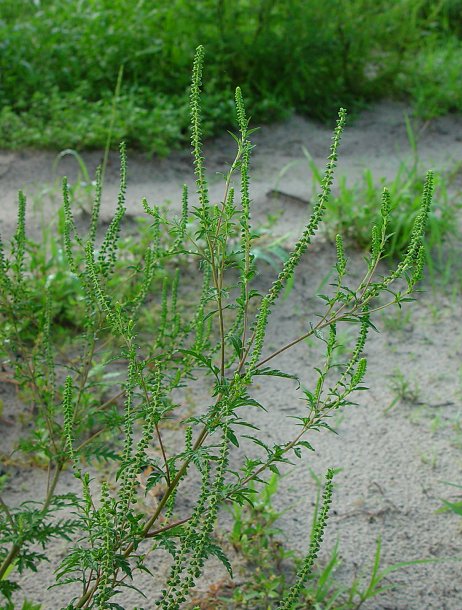Ambrosia artemisiifolia L.
Common Ragweed

Native
CC = 0
CW = 3
MOC = 79
© DETenaglia
Ambrosia artemisiifolia L.Common Ragweed | |
 |
Native CC = 0 CW = 3 MOC = 79 |
© DETenaglia |
|
Family - Asteraceae/Heliantheae Habit - Taprooted annual forb.
Stems - Ascending, to 1.2 m, branched, pubescent with long, spreading hairs and usually also with shorter hairs.
Leaves - Opposite at the base, alternate toward stem tips, petiolate. Petioles narrowly winged. Blades to 10 cm, mostly broadly ovate, 2-3 times pinnately lobed with more than 5 primary lobes. Ultimate segments narrowly lanceolate or oblong, entire or few-toothed, variously hairy, usually somewhat canescent.
Inflorescences - Inflorescences of separate staminate and pistillate heads, the staminate heads in spikelike racemes terminal on the branch tips, the involucre 2-4 mm wide, with 3-9 shallow lobes, glabrous or sparsely hairy. Pistillate heads sessile, solitary or in clusters toward the base of the staminate spikes or in the adjacent upper leaf axils. Pistillate heads in small axillary clusters, the involucre enclosing 1 floret and with 1 beak, 3-5 mm long at fruiting, more or less ovoid, with 1 series of short spines in a ring toward the tip, sparsely to moderately hairy.
Flowers - Heads discoid, the staminate heads pendent. Receptacle flat, that of the staminate heads with chaffy bracts, these narrowly linear to narrowly lanceolate, usually hairy and sometimes also glandular. Staminate heads with 10-150 disc florets, the stamens with the filaments fused into a tube, the anthers free but closely adjacent to one another in a ring, the corolla 2-4 mm long, narrowly bell-shaped, white to pale yellow, sometimes purplish-tinged toward the tip, usually minutely hairy and often also glandular. Pistillate heads with 1 or 2 florets, the corolla absent. Pappus absent.
Fruits - Fruits 3.0-4.5 mm long, more or less globose to ovoid, grayish tan to nearly black, glabrous, completely enclosed in the persistent pistillate involucre and dispersed as an intact bur. Flowering - July - November. Habitat - Fallow and waste fields, disturbed sites, pastures, glades, roadsides, railroads. Origin - Native to the U.S. Other info. - This common ragweed species is probably found in every part of Missouri, as well as most of the U.S. and well into Canada. It is a challenge for allergy sufferers, producing copius quantities of the pollen which is a major cause of hay fever. Although the plants provide food for wildlife such as turkey, cattle and livestock are apparently nauseated by consuming the plant, and it is often ignored in pastures. It is a problem weed in agricultural fields, and anecdotal reports have recently suggested that glyphosate-resistant strains have begun to emerge. Photographs taken in Winter Haven, FL., 6-28-02 (DETenaglia); also at Don Robinson State Park, Jefferson County, MO, 8-9-2024 (SRTurner). |